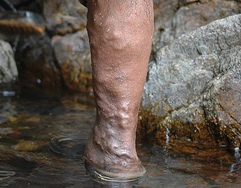Primary and secondary venous insufficiency
It is an expansion of the superficial veins respectively veins of the superficial venous system of the lower extremities. It is one of the most common diseases in developed countries. It has been found out that by the age of fifty, half of the population already has some form of venous insufficiency.
Varicose veins also called varix of the lower extremities are divided into:
- primary (idiopathic) and
- secondary (postthrombotic).
Primary varix[edit | edit source]
The most common type of varicose veins. A certain level of dilatation of DK veins is seen in half of adult men and 2/3 of women. A more severe form of the disease occurs in up to 20% of the population.
Forms of varices[edit | edit source]
- Microvarices;
- reticular (affects smaller veins);
- trunk varices (affects v. saphena magna and/or parva).
Pathogenesis[edit | edit source]
The genetic background of the congenital weakening of the vein wall and immobility of the venous valves has a great influence. The effect of progesterone is also involved. Another important factor of pathogenesis is valve insufficiency in the junctions between the deep and superficial systems whick leads to over-pushing blood from deep na povrch during working muscle pump.
An additional factor for the formation of the varices can be increased intra-abdominal pressure, working while standing, sitting. Congestion occurs in the venous system, resulting in capillary proliferation, increased permeability of the vascular wall, and subsequently the leakage of substances into the interstitium (fibrinogen).
Klinical pciture[edit | edit source]
At first, varicose veins are just a cosmetic problem. Then there are typical problems - feeling of heaviness or tension in the limbs' (especially in the evening, in the hot weather), night cramps, burning or itchy skin, eczema' to leg ulcer.
Among the main complications of varicose veins are thrombophlebitis' and rupture of varix.
Diagnosis[edit | edit source]
The extent of the varicosities can be determined by physical examination. Continuation of the pressure wave induced by tapping on the varices distally is indicative of valve insufficiency. By palpation, it is possible to detect enlarged openings in the fascia, through which insufficient perforators pass.
Basic tests – Perthes test and Trendelenburg test – they are not used anymore. These days we use ultrasonography, USG for diagnosis.
Therapy[edit | edit source]
Minor phlebectases can be treated with injections of a sclerosing solution followed by a compression bandage. If the whole saphena is relatively well and only small vein branches are dilated , we will remove them by small incisions.
Typical operation for affected saphenous veins – Babcock's operation (stripping). Based in the careful dissection of the point of entry of the saphena magna into the femoral vein in the "fossa ovalis" in the groin . At this point, we ligate all venous tributaries(v. circumflexa ilium spf., v. epigastrica spf., vv. pudendae ext.) and we cut the trunk at the outlet. Then we dissect the saphenous vein in front of the inner ankle and insert the endostripor. We pass the wire through the saphenous vein. At the end, it has an extension on which the entire saphena is inserted when the wire is pulled through the canal.
Both saphenous veins are used for bypass, that is why it is important to consider this operation very carefully. We always try to ligate insufficient perforators.
Secondary varices[edit | edit source]
Pathogenesis[edit | edit source]
Consequences of the deep vein thrombosis: Hypertension in the superficial venous system during deep vein occlusion. Possibly due to post-thrombotic syndrome – damage to the valves of the deep veins during recanalization trombosis.
Klinical picture[edit | edit source]
They tend to be smaller and more dispersed. Skin changes, eczema, skin atrophy with pigmentation and leg ulcer develop more quickly. To diagnose the development of the disease is used ultrasonography' and also flebography.
Therapy[edit | edit source]
Mostly conservative – suitable position, bandaging, taking care of skin. In the case of a leg ulcer, it is good to ligate the supply vein and cover the ulcer with skin grafts.
- Occlusion of pelvis vein – cross-over bypass sapheno-femoral.
- Occlusion of femoral vein – safeno-popliteal bypass.
References[edit | edit source]
Related articles[edit | edit source]
Source[edit | edit source]
- BENEŠ, Jiří. Studijní materiály [online]. [cit. 28.6.2010]. <http://jirben.wz.cz>.
- ČEŠKA, Richard, ŠTULC, Tomáš, Vladimír TESAŘ a Milan LUKÁŠ, et al. Interna. 3. edition. Praha : Stanislav Juhaňák - Triton, 2020. 964 pp. pp. 239-242. ISBN 978-80-7553-780-5.






